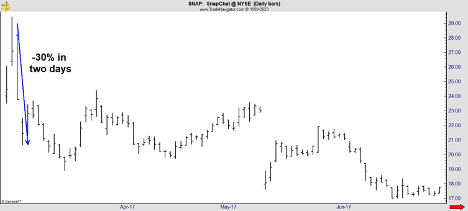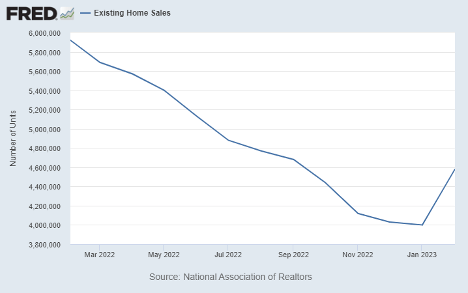[ad_1]
Profitable startups observe a typical sample.
An entrepreneur has an thought. They begin a enterprise. After a short while, the enterprise makes cash.
Beginning the enterprise is difficult. Entrepreneurs usually want capital. Beginning a small enterprise on Principal Road would possibly require $100,000, for instance.
To get the cash, the founder goes to the financial institution. Bankers evaluate the marketing strategy. Additionally they evaluate the proprietor’s belongings. Bankers need to guarantee they get repaid with curiosity.
That is laborious work. However all around the globe, small companies safe capital and plenty of discover success.
The method is somewhat completely different within the tech sector.
You continue to want the concept. You continue to want to seek out cash. However, not less than for the previous 15 years, income weren’t essential.
Tech shares operated on a distinct dynamic, absent of profitability. And, because of the financial system of the final 15 years, that labored.
But when that financial system was Kansas, we’re not in Kansas anymore. As apparent because it sounds, corporations will now want to really make cash to maintain the lights on.
This all has to do with a serious change that occurred within the financial system final yr. One which put profitless tech corporations in peril…
However merely avoiding these received’t save your retirement. Even nice shares are caught within the crossfire on this new period. And since these nice shares make up a majority of your entire market, there’s nearly no place to cover.
At this time, I’ll share precisely why tech corporations are in a lot hassle, and why that hassle is basically simply getting began.
However I’ll additionally present you the one factor it is best to change about your investing model in the event you’re going to maintain creating wealth despite tech’s continued downfall…
The Damaged Mannequin of Funding within the Tech Sector
Let’s take a look at an instance that completely illustrates what I’m speaking about…
Snap (SNAP) is a social media firm. They run an app referred to as Snapchat.
This app permits you to ship messages or footage to different customers. The twist is the messages disappear after a couple of minutes.
It seems like a small market, mainly for individuals who have one thing to cover.
Additionally they enable public sharing of messages and pictures. That’s most likely a canopy for individuals who need the non-public messages that disappear.
Whereas I don’t use Snapchat, about 375 million folks do.
375 million prospects sounds nice … however the product is free. So how does the corporate make income?
It pushes advertisements to customers of its free app, and in concept, that’s how they make cash.
This received’t shock you, however the actuality is completely different from the speculation.
The chart beneath reveals the corporate’s income and web revenue because it went public in 2017. Firms going public should file knowledge from earlier years, so the chart goes again to 2015.
The inexperienced bars present the corporate’s whole income. Up, up and away. Nice, proper?
However income isn’t necessary in the event you don’t hold it. The purple bars present Snap’s web revenue, which has been destructive for its complete existence.
Snap has by no means reported optimistic revenue over a 12-month interval. The scale of the loss ranged from $373 million to $3.5 billion.
So, the place did the income come from? The customers watching the advertisements, proper?
Fallacious. The cash got here from enterprise capital (VC) buyers.
Enterprise capital companies fund tech startups. These companies don’t all the time deal with income. They have an inclination to focus extra on their exit technique.
For Snap, the exit technique was an preliminary public providing (IPO). This allowed the VC companies to promote their stake to most of the people. VC companies put in a complete of about $2.6 billion. The IPO raised greater than $32 billion. They made their cash — all $29.4 billion of it — the second SNAP listed.
Shares of SNAP instantly dropped.
That is smart. The enterprise doesn’t revenue.
The inventory did soar within the pandemic restoration as particular person buyers chased tech shares. However whereas people had been buying and selling SNAP, VC companies had been cashing out of different investments.
In 2021, 1,035 corporations and special-purpose acquisition corporations got here public. Every considered one of them represents a payday for enterprise capitalists.
For the final 15 years, VC companies didn’t want many corporations to ship large returns like SNAP. If simply 1 out of 10 does, they’ll make a big amount of cash.
However now the sport is completely different. And that brings me to why tech corporations had been so enticing within the late 2010s, and why they’re so unattractive now.
The Tech Sector Is “Leaving Kansas”
When VC companies first checked out Snap 10 years in the past, rates of interest had been zero. This implies they may borrow cash just about without cost. They may throw that cash round in any respect types of profitless corporations and see what labored.
Now, rates of interest are greater. A lot greater. So companies now want to point out they’ll ship returns which are greater than the risk-free yield obtainable in Treasury bonds.
It is a downside for a lot of companies within the tech sector. If capital carries a value, they’ll’t ship merchandise beneath value they usually can’t develop a buyer base.
Firms like Uber are working into this downside. Prospects beloved Uber when rides had been low cost. Enterprise capital is what made these rides low cost. With out these funds, rides are dearer. And Uber isn’t as in style.
For those who learn my work, you understand I blame the Federal Reserve for every little thing. The Fed broke the monetary system. That led to the present banking disaster.
The Fed additionally broke the tech sector. Free cash allowed unhealthy corporations to outlive. With greater charges, these corporations are failing.
However the Fed is now additionally breaking issues not directly. Even well-run corporations are compelled to chop prices. Worthwhile corporations like Meta, Amazon and Google, are shedding 1000’s of staff.
That doesn’t imply some pampered tech staff are looking for new jobs. This implies the financial system round tech facilities is contracting. And the worst a part of the contraction nonetheless lies forward of us.
That’s why it’s necessary to deal with the brief time period on this market.
I anticipate this bear market to final for months. I don’t consider shopping for all the best way down and hoping for a Fed pivot or a market turnaround will probably be a successful technique.
I’d a lot fairly take a single commerce on daily basis, with excessive odds of delivering a 50% achieve in two hours, than I’m ready doubtlessly years for a long-term 50% achieve.
That’s not a hypothetical. That’s the purpose of my latest trading system, which I first unveiled to the general public one hour in the past.
I commerce this method each single day in a stay Commerce Room with my subscribers. I place the trades with my very own cash. And to this point, outcomes have been extremely passable.
If the market delivers poor returns for the whole lot of this high-interest-rate period, and it lasts so long as I anticipate, this ability will probably be important to beating each the market and beating inflation.
I’ll educate you this ability within the Commerce Room. To be taught how one can be part of, go here for all the small print.
Regards,
 Michael CarrEditor, One Commerce
Michael CarrEditor, One Commerce
Tech Isn’t the Solely Sector Completely Depending on Low cost Cash
Tech shares have been rallying this yr, even with the fears of a contagion within the financial institution sector. The tech-heavy Nasdaq is up about 14% year-to-date.
Evidently, it doesn’t matter what the Fed says, the market is pricing in that the speed hikes will probably be petering out quickly. As Mike factors out, tech shares are wildly delicate to rates of interest, as a result of their anticipated income are sometimes years, and even many years sooner or later.
However tech shares aren’t the one winners from this hope that the worst of the credit score tightening is behind us.
The housing market seems to be again from the lifeless. Current dwelling gross sales jumped by 14.5% final month to an annualized fee of 4.58 million.
Now, these numbers are nonetheless down by greater than 1 / 4 from the degrees of early 2022. Nevertheless it’s good to see a extremely nasty downtrend like that lastly break.
Why Are Residence Gross sales Rising?
Nicely, it boils right down to rates of interest.
Demand for housing by no means actually slacked. Millennials are of their peak home-buying years, and excessive lease’s give them that additional nudge to purchase.
The massive decline in dwelling gross sales over the previous yr was the problem of affordability. With mortgage charges greater than doubling final yr to over 7%, gross sales fell off a cliff. So many would-be consumers weren’t in a position to get financing or realistically make the funds.
Nevertheless, by early February, the common mortgage fee had dipped to six%. This, mixed with a slight lower within the common dwelling worth over the previous eight months, was sufficient to maneuver the needle.
What Occurs Subsequent?
We’ll see. Inflation remains to be working scorching, and the Fed is conscious it must get it below management. Nevertheless it’s additionally not significantly enthusiastic about having to cope with one other banking disaster.
Not that I really feel sorry for Chairman Jerome Powell. This was a large number of his personal making by holding rates of interest pegged at zero for much too lengthy.
However now, with one hand, he faces the unattainable balancing act of making an attempt to take liquidity out of the system. With the opposite hand, he’s injecting liquidity into the system to keep away from a banking meltdown.
This isn’t an atmosphere the place I’m assured sufficient to dump cash into an index fund and be achieved. However that additionally doesn’t imply I’m good with sitting on my fingers for a number of months, or presumably even years.
If I’m not rising my portfolio, I’m dropping floor to inflation.
At this time, about two-thirds of my portfolio is invested in short-term buying and selling methods, with a time horizon usually measured in days. That’s the place I’m essentially the most snug proper now.
After all, Mike is aware of a factor or two about short-term buying and selling. He has a technique with a time horizon measured in hours. To see what Mike is doing, see his presentation referred to as the “9:46 Rule.” It outlines the right time for short-term buying and selling, and how one can maximize your investments on this market.
Regards,
 Charles SizemoreChief Editor, The Banyan Edge
Charles SizemoreChief Editor, The Banyan Edge
[ad_2]






